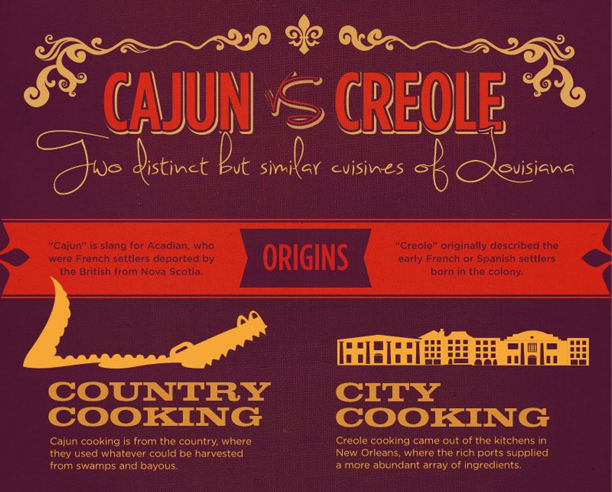Cajun or Creole?

Which Is It? Cajun or Creole?
I was in Lafayette on Friday. My wife and I made the 2-hour drive to join our friends in their celebration of the Sacrament of Matrimony. The wedding was BEAUTIFUL! Celebrated in the Cathedral of St. John the Evangelist in Lafayette, the Nuptial Mass highlighted the beautiful and lofty call of the vocation of marriage. The happy couple was blessed to be surrounded by so many people… family, friends… and clergy! There were five priests in the sanctuary and one deacon!
Lafayette is in southWEST Louisiana, whereas New Orleans is in southEAST Louisiana. And Baton Rouge – where I grew up – is right in the middle.
Growing up, Lafayette and New Orleans geographically represented for me the differences between Cajun and Creole. Lafayette was full of Cajuns, and New Orleans was full of Creoles. I grew up knowing the difference. It was just part and parcel of our south Louisiana culture. But you might be wondering what exactly is a Cajun? And what is a Creole? These are common questions that I get as I share Cajun and Creole recipes here at CatholicFoodie.com and on The Catholic Foodie Podcast. And I am very happy that the good folks with Marriott Louisiana Hotels have put together this detailed and attractive infographic to highlight the differences between Cajun and Creole cuisines.
Both Cajuns and Creoles have French origins, so what’s the difference?
What is a Cajun?
“Cajuns are hardy people, proud of their heritage and of the unique civilization they’ve carved out for themselves in southern Louisiana. To understand the Cajun people, you have to understand their story. It is a story of struggle, a story for the ages. They began as French settlers in the remote settlement of Acadie, on the southeast coast of Canada, in the early 1600s. For a century, they lived a simple life in relative isolation, surviving as farmers, trappers and fishermen. During this time, a particular culture and dialect began to take shape.
During the French and Indian War of the mid-1700s, the British expelled them from their homes and burned their villages, scattering thousands of Acadians across North America, the Caribbean and France. They were left destitute and suffered greatly during this exile.
Beginning in 1765, and continuing over the next two decades, Acadians began arriving in Louisiana by the hundreds, gradually coming to be known as Cajuns. Though the Louisiana climate was different, they were able to employ the trapping, fishing and farming skills they had honed in Canada. They also resumed a life of relative isolation for another century, placing their development as a people back into a cultural crucible.” – You can read more about the history of the Cajuns at: http://www.louisianatravel.com/roots-cajun-culture
When it comes to cuisine, think of Cajun cooking as “country” cooking, meaning that the cuisine is a bit more rustic. Cajuns utilized whatever they could find from the swamps and bayous in their cooking. Large one-pot meals were the norm, like gumbos, stews, and jambalayas.
What is a Creole?
The definition of the word Creole as it applies to people is a bit more difficult to nail down. The word is used in a variety of ways. However…
“The commonly accepted definition of Louisiana Creole today is the community whose members are a mixture of mainly French, Spanish, African, and Native-American heritage.” – Louisiana Creole People
When it comes to cuisine, you can think of Creole as “city cooking” that is more refined than what you see in Cajun country. New Orleans is a port city, which meant that the people of New Orleans and the surrounding areas had access to spices and ingredients that were not naturally available to the Cajuns over in the southwest. This one simple difference had a huge impact on Creole cooking.
Two of our most well-know Louisiana dishes – Jambalaya and Gumbo – provide a simple example of the difference between Cajun and Creole cuisines. Both the Creole Jambalaya and Gumbo feature tomatoes. But you will find no tomatoes in the Cajun version of those dishes. As a matter of fact, Creole jambalaya is sometimes called “red jambalaya.” It almost always contains the “trinity,” which – in case you don’t know – refers to onion, green bell pepper, and celery… the basis of so many Cajun and Creole dishes. Often you’ll find shrimp in red jambalaya in addition to the chicken, and sometimes in place of it. Some folks like to throw ham in too.
Brown (or Cajun) Jambalaya, on the other hand, contains no tomatoes. No seafood either. You will probably find the “trinity,” and you will definitely find Andouille sausage, chicken, and sometimes pork chops in Cajun Jambalaya.
Thanks again to the folks at Marriott Louisiana Hotels for the infographic below.
What’s your favorite Cajun or Creole dish? Tell me in the comments below!

Cajun vs. Creole Louisiana Food – An infographic by the team at Marriott Louisiana Hotels